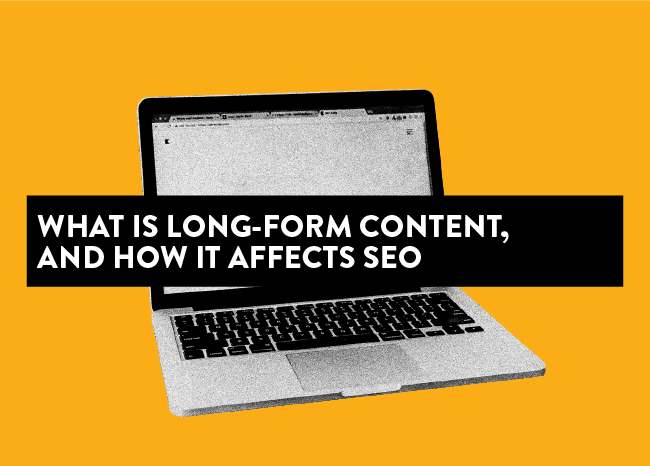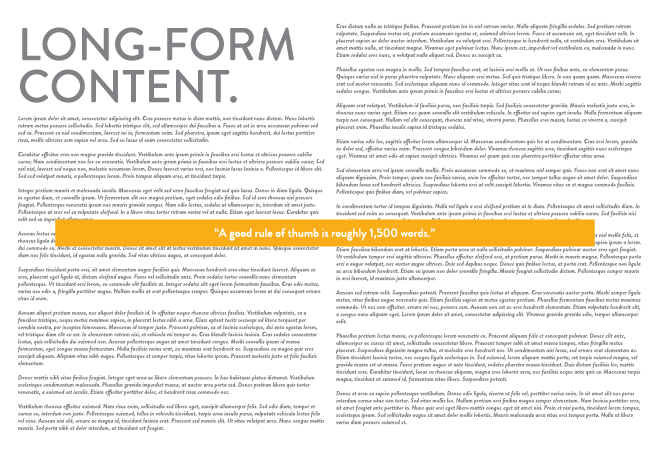
Long-form content can be critical to winning in the SERPs.
Google’s goal is to rank the content that best answers the users’ intent and query. Sometimes, when creating content for a competitive keyword, you’ll find only guides and long pieces of content ranking. This will be your signal that you’ll likely need long-form content yourself in order to compete.
What is Long-Form Content?

Long-form content is in-depth content, going beyond traditional blog posts. This can mean different lengths to different content marketers, industries, and individuals. Typically, this type of content helps readers thoroughly understand a complex topic while also helping to establish your authority and expertise.
There is some contention as to how this type of content fairs compared to shorter-form content, as well as how the two types of content can be utilized simultaneously to build towards larger goals. However, evidence suggests that long-form content does tend to perform well in several areas related to SEO.
How Long Is Long-form?
 There is no absolute standard for how long a piece of content must be in order to be considered “long-form.” In short, long-form content is longer than a typical article created for a layman’s online audience, taking more time to consume. A good rule of thumb is roughly 1,500 words.
There is no absolute standard for how long a piece of content must be in order to be considered “long-form.” In short, long-form content is longer than a typical article created for a layman’s online audience, taking more time to consume. A good rule of thumb is roughly 1,500 words.
Articles vary in length, so it is often down to the individual content marketers, SEO professionals, and agencies to define which content is long-form.
Long-form vs. Short-form Content
The most noticeable difference between long-form and short-form content is the length and goals of the content.
Shorter-form content is typically focused on one specific topic or facet of a topic. This is especially true of keyword content. To create clear keyword signals and focused content on a particular topic, addressing separate keywords and related topics in different articles can be helpful. Furthermore, by keeping the content focused on a specific concern, you provide the audience with detailed and useful information while maintaining future runway to build out your content.
Long-form content often expands much further on a topic, covering many related sub-topics simultaneously.
Long-form content may be the correct approach depending upon:
- The length of the content currently ranking for the target keyword(s).
- The existing authority of the domain.
- The type of content housed in the domain.
- The SEO goals for the domain.
- The particular approach that the SEO professional chooses.
Another reason a content marketer or SEO may choose long-form content is to build links. A highly comprehensive and well-researched article may act as an appealing resource to other websites that want to cite sources that demonstrate expertise. As such, long-form content can be one tool for earning valuable backlinks.
Types of Long-form Content
There are many types of long-form content that websites, content marketers, and SEO professionals may create:
- In-depth guides
- Audience resources
- Case studies
- Video content
- Podcasts
- Tutorials
- Documentaries
Written forms of content are the most typical type of long-form content used for SEO.
Do You Need Long-form Content?

Long-form content is often a valuable tool in the SEO toolbox. As such, it often represents a valuable opportunity. However, it is not an absolute necessity. Whether you need long-form content depends on your specific SEO goals and strategies, as well as what information about competitor content you find in your analysis and research. If much of the highly-ranking content on that particular topic is long-form, that is a strong indicator that your piece should be long-form as well.
Advantages of Long-form Content

To determine whether long-form content will be necessary for your SEO strategy, you first need to set your goals and understand the advantages of long-form content.
Optimizing for Search
Long-form content can help SEO professionals optimize for search in various ways, including:
- Improved keyword signals: Long-form content can strengthen keyword signals on websites by thoroughly exploring information related to valuable keyword phrases relevant to your website’s goals.
- Strengthened authority signals: Long-form content can strengthen authority signals by earning backlinks and developing relationships with authoritative entities.
- Build site relationships: By providing valuable, high-quality resources to other websites, you can build relationships with webmasters, and these relationships can be assets going forward.
Much of these benefits are better supported with the strategic combination of short-form and long-form content.
Building Credibility
Long-form content can also build a website’s credibility. This is accomplished through several different means, including:
- Brand building: Providing high-quality long-form resources to other websites can draw the eyes of new people and familiarize them with your brand.
- Networking: Having a high-quality long-form resource can offer an opportunity to reach out to reputable organizations as you pitch the value of the resource, thus potentially establishing a professional relationship.
- Demonstrating expertise: If you ensure that your long-form content is presented in a professional manner and offers valuable information and unique insights, you can demonstrate expertise to your audience.
- Demonstrating professionalism: Every piece of content that you produce is an opportunity to convey professionalism to your audience through the quality of the work.
- Providing unique, high-quality content: As the saying goes, good work speaks for itself. High-quality content can help you develop your credibility – especially if the content offers something unique to the audience.
If building credibility is a goal for your SEO efforts, long-form content will be valuable to improve audiences' perception of your website and content.
Earning Links
Long-form content can earn valuable backlinks by compiling information, research, and resources that are built to be useful citable sources for other websites.
By creating a highly comprehensive piece, you ensure the resource is valuable to a wide variety of organizations and websites. You may further guarantee success in this endeavor by reaching out to reputable organizations and websites that you think would want to share with their audiences in the form of an organic link to your long-form resource. This tactic could be mutually beneficial.
Risks of Long-form Content

There are potential drawbacks to long-form content.
Effort Needed To Produce
Longer content takes longer to produce.
This is especially true if you create content that is unique and high quality. Spending a long time creating a piece of content can be mentally draining for the one making it. Therefore, it is important to ensure you have the necessary resources to produce such content before you begin.
Sunk Cost
Because of the additional effort often needed to produce long-form content, you will often need to use more of your resources to accomplish it. More time, money, and employee effort will typically be required. As such, there is more risk of loss if the content does not end up performing well.
It’s not unusual for organizations, content marketers, and SEOs to over-invest in long-form content that fails to achieve the goals set out.
Better Alternatives
In some cases, long-form content may not be the best option for approaching a particular goal or topic. Always weigh alternatives before settling on your approach. This is particularly true for long-form content since it is a larger drain on resources than other types of content.
How To Write Long-form Content

Long-form content requires strategic development and a plan.
Know Your Audience
The first step in developing any content is to understand your audience. Here are some key audience characteristics that you should know and consider when developing long-form content:
- Your target demographics
- Current responsive demographics
- Where your target audience spends time online
- How your target audience behaves online
- What type of content your target audience engages with
- Gaps in knowledge across your audience
- How your audience has evolved, and where they may yet evolve
Regularly re-evaluate your audience. It is vital you understand all of the ins and outs of your audience, as well as the content itself. If you find that the particular topic requires more length to provide a thorough explanation, then you should add that length.
Define the Intent
Never jump into developing a piece of content without having specific goals in mind.
You will want to establish parameters for your key performance indicators (KPIs) and outline your strategy. This will help you have more certainty when evaluating whether or not a piece of content has fulfilled its purpose.
For search, you’ll also want to determine searcher intent. Understand what your target audience is searching for and what terms they are using to search for it. Then create content that clearly addresses the information that they are looking for.
Start With an Outline
Starting with an outline is another way to ensure you are developing the best piece of content possible. An outline will also help you remember key internal linking opportunities to include, as well as valuable resources to pull information from. You should also embed target keywords throughout the outline.
The following elements are often present in effective outlines for long-form SEO content:
- Optimized subheadings
- Summaries and examples for each section
- Suggestions for reputable external sources
- Notes about opportunities for internal links, along with the suggested links
- Clear directions for the writer
- Client and editor notes
Outlines also help clients understand what the final product will be before committing to the project.
Craft a Strong Introduction
A strong introduction is not only a valuable way to draw interest, but also signals to readers early on that the content will sufficiently address their questions or interests.
Introductions should answer simple questions and offer basic definitions up front, as well as touch on what information will be discussed in the body of the content. The introduction will also serve to provide a first impression in terms of your tone and professionalism.
Break the Content Into Chunks
Ideally, you should break the information presented in your content by category. Then use these categories to separate the content into chunks divided by structural elements such as subheadings and paragraph breaks.
In doing this, you can reduce reader fatigue that may be caused by large blocks of text, and make it easier for the reader to skip to the information that is relevant to them. The use of bullet points can also provide similar benefits.
Making Long-form Content Work for You

In short, long-form content offers a variety of benefits for online content marketing, especially as it concerns the development of keyword and authority signals vital to search engine optimization. However, it is important to identify the right time to utilize it rather than to start publishing long-form content just for the sake of publishing it. Without a proper strategy to back it up, long-form content cannot achieve its full potential.

